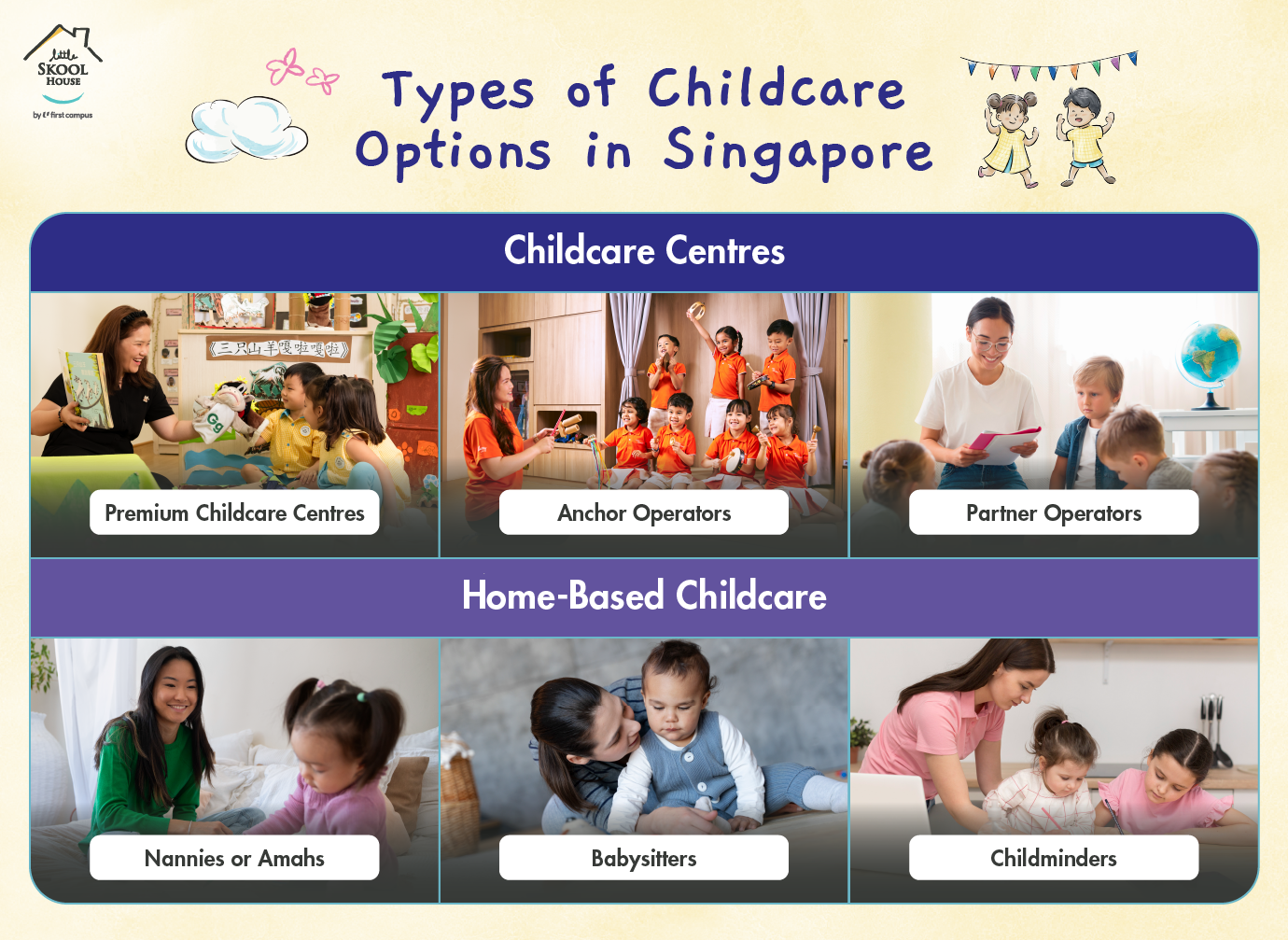BACK

Choosing the right childcare is one of the most important decisions a parent can make. In Singapore, options are plentiful, each offering unique environments and learning experiences.
For many families, finding a centre that nurtures curiosity, builds strong foundations, and inspires a love for learning is key. Considerations often include the curriculum, language exposure, and classroom environment—some reputable centres, like Little Skool-House, offer an enriched curriculum, bilingual education, and low teacher-to-child ratios to support well-rounded development.
In this guide, we’ll explore the types of childcare available, their costs, and how to make the best choice for your child.
Comparing the Cost of Childcare in Singapore
| Childcare Option | Cost Range | Key Features |
| Childcare Centres | ||
| Premium Childcare Centres (e.g., Little Skool-House) | Starts from $2,300 | Enriched curriculum, bilingual education, low child-to-teacher ratios, high-quality care |
| Anchor Operators (AOP) | Starts from $640 per month before subsidies | Supported by the ECDA AOP scheme, regulated programs, and affordable fees with government subsidies |
| Partner Operators (POP) | Starts from $680 per month before subsidies | Supported by ECDA POP scheme, good teaching standards, and affordable rates |
| Home-Based Childcare | ||
| Nannies or Amahs | Starts from $2,900 per month | Personalised care, flexible hours, in-home childcare |
| Babysitters | Starts from $15 per hour | On-demand care, flexibility for short-term needs |
| Childminders | Starts from $1,200 per month | Small group care in a home-like setting, structured activities |
When considering the cost, it’s important to look at the net fees, which are the actual amounts parents pay after government subsidies are applied.
Types of Childcare Options Available
In Singapore, parents have a wealth of childcare options to choose from, each tailored to different needs, family routines, and budgets. Understanding the features of each option will help you make an informed decision that best supports your child’s development and your family’s lifestyle.
Childcare Centres
Childcare centres and preschools remain one of the most popular choices due to their structured learning environments that foster both academic and social growth. These centres generally fall into four categories:
Premium Childcare Centres (e.g., Little Skool-House)
Premium childcare centres, such as Little Skool-House, offer an enriched curriculum that prioritises holistic development. These centres are designed to provide:
- Bilingual Education. A focus on both English and mother-tongue languages to support cognitive growth and communication skills.
- Low Child-to-Teacher Ratios. Ensuring individualised attention for each child.
- Enriched Learning Environments. Thoughtfully designed spaces that encourage exploration and creativity.
- High Standards of Care. With experienced educators and well-structured programs, premium centres aim to foster curiosity, independence, and social skills in children.
Monthly Cost: Premium centres often range between $1,500 to $2,500 per month, reflecting their commitment to low teacher-child ratios, bilingual education, and enriched learning environments.
Anchor Operators
Supported by the government, anchor operators provide quality care at a more accessible price point. Key features include:
- Regulated Programs. Adherence to the Early Childhood Development Agency (ECDA) standards for a balanced curriculum.
- Subsidy Eligibility. Families can benefit from government subsidies, making these centres a cost-effective option. Families with lower incomes can qualify for higher subsidies, further reducing the cost of childcare at anchor operators.
Monthly Cost: Supported by government subsidies, anchor operators like My First Skool charge up to $720 per month before subsidies. Eligible families can significantly reduce costs with the Basic and Additional Subsidies.
Partner Operators
Partner operators bridge the gap between affordability and quality. These centres generally offer:
- Community-Based Care. Often smaller, with community-oriented centres that focus on fostering a supportive learning environment.
- Good Teaching Standards. While fees are typically lower, these centres maintain solid educational standards, ensuring children receive a good start to their education.
- Accessible Fees. Partner operators often provide a balance of high-quality care at a more affordable rate than premium centres.
In some cases, non-working parents may apply for special approval to receive additional financial support for childcare at partner operators.
Monthly Cost: Fees for partner operators typically range up to $800 per month, providing a balance of quality care and affordability, with subsidies available to further reduce costs.
Home-Based Childcare
For families seeking a more intimate and flexible approach, home-based childcare offers a more personalised experience in a familiar setting. Home-based childcare options often offer more flexibility in terms of working hours, accommodating parents’ schedules more easily. This option is particularly suited for families who desire one-on-one attention or a smaller group environment. Common types include:
Nannies or Amahs
These caregivers work directly in your home, providing customised care and attention to your child. Features include:
- Personalised Care. One-on-one attention in a comfortable, familiar setting.
- Flexibility. Nannies often have more flexible hours compared to childcare centres.
Monthly Cost: Full-time nannies generally cost between $2,900 to $3,500 per month1, depending on their experience and responsibilities. Live-in options may be slightly more affordable but include considerations like food and lodging.
Babysitters
Ideal for short-term or occasional care, babysitters offer flexibility, such as:
- On-Demand Care. Perfect for date nights, emergencies, or during school breaks.
- Hourly Rates. Usually more affordable than long-term care options.
Some babysitting services may also charge a registration fee, which varies depending on the agency.
Hourly Cost: Babysitting services charge around $15 to $35 per hour, making them ideal for short-term care needs.
Childminders
Licensed caregivers who look after small groups of children in their own homes. Features include:
- Cosy, Home-Like Environment. A smaller, nurturing space that may feel more comfortable for young children.
- Structured Activities. Childminders typically offer scheduled activities that support early learning in a low-pressure environment. Childminders often tailor their care and activities based on the child’s age, ensuring appropriate developmental support.
Monthly Cost: Fees for childminders generally fall between $1,200 to $2,800 per month2, offering a homely environment for children at a relatively lower cost.
Government Subsidies and Financial Support
The Singaporean government offers several subsidies to help make childcare more affordable for families. These subsidies, which are only eligible for Singapore citizen children, can significantly reduce the financial burden of childcare fees, especially for working parents.
Childcare Subsidies
The government provides childcare subsidies to parents who place their children in licensed childcare centres, including Little Skool-House. The subsidies vary depending on several factors such as household income, the type of childcare centre, and the parents’ working status.
- Working Mothers Subsidy (WMS). Available to parents who are working full-time or part-time, the WMS can cover up to $600 per month for children attending childcare centres. This subsidy applies to both local and international centres.
- Infant Care Subsidy. For parents with infants aged 2-18 months, the government offers subsidies that can cover up to $1,200 per month for infant care at licensed centres. This support helps families with younger children who need specialized care and education.
- Additional Subsidies for Lower-Income Families. Families with lower household incomes can access additional subsidies, which help make childcare more accessible to all. These subsidies can provide up to $800 per month for childcare services.
ECDA subsidies are applied directly to the childcare fees, making it easier for parents to manage their expenses.
Subsidies for Non-Working Parents
Parents who are not employed can also benefit from subsidies, although the rates are typically lower. The government offers support through the Non-Working Mothers Subsidy, which helps make childcare more affordable for stay-at-home parents.
Eligibility for these subsidies is often determined based on the family’s per capita income, ensuring that larger families with lower incomes receive adequate support.
Additional Financial Support Options
In addition to childcare subsidies, parents can also look into financial assistance programs offered by specific childcare centres, such as discounts for multiple children or sibling rates. Some centres may also have partnerships with employers that provide childcare benefits, further easing the financial load for parents.
Many childcare centres receive funding from government schemes, which helps them keep their fees affordable for parents.
Key considerations when choosing a childcare
Choosing the right childcare arrangement for your child’s needs is one of the most important decisions you’ll make as a parent. It’s not just about the cost; it’s about finding the environment that aligns with your values and your child’s developmental needs.
Here are a few key considerations to help you make a thoughtful choice:
1. Your Child’s Needs
Consider your child’s age when selecting a childcare option, as different programs cater to various developmental stages. If you value a structured learning environment with a strong emphasis on holistic development, premium childcare centres like Little Skool-House offer a nurturing curriculum tailored to your child’s needs.
2. Your Family’s Schedule
If you have a demanding work schedule, look for childcare options that offer flexibility, such as extended hours or emergency care services. Full-day childcare options can provide the necessary coverage for parents with demanding work schedules. For working parents, government subsidies can help offset the cost, making quality childcare more accessible.
3. Budget Considerations
While premium childcare centres may come with higher fees, they also offer superior educational programs and a carefully crafted environment that encourages your child’s growth. Weigh the costs of different options, considering any available subsidies and financial support to find the right fit for your budget.
4. Long-Term Benefits
Investing in quality early childhood education pays off in the long run. Children who attend centres with a strong educational foundation, such as Little Skool-House, tend to have a smoother transition into primary school and a greater love for learning.
5. Peace of Mind
Above all, choose an option that gives you peace of mind. A safe, nurturing, and educationally rich environment ensures that your child is not only cared for but is also thriving. Premium childcare centres assure that your child’s well-being and development are the top priority.
The right childcare decision is a balance of your child’s needs, your family’s budget, and your long-term educational goals.
By exploring all your options and considering both the financial and emotional investment, you’ll be able to make the best choice for your child’s future.
Give your little one the confidence to shape their own path: Little Skool-House
Selecting the right childcare option is a decision that shapes your child’s early learning journey and lays the foundation for their future.
In Singapore’s diverse landscape of childcare options, finding a centre that nurtures curiosity, fosters holistic development, and provides high-quality education is crucial.
So when it comes to premium early childhood education, Little Skool-House stands out. With our enriched kindergarten curriculum, bilingual education, and low child-to-teacher ratios, Little Skool-House is dedicated to creating a nurturing environment where children thrive academically, socially, and emotionally.
Choose Little Skool-House—where learning is inspired, and every child is prepared for a bright tomorrow.
Choose from 20 Conveniently-Located Centres
Discover the Little Skool-House Difference
Register Now for a Journey of Learning and Growth.
- Award-winning teachers
- Proven bilingual curriculum
- Trusted by parents across Singapore
Limited slots available. Secure your child’s place today.
Sources
- https://www.nannypro.com.sg/services/the-rates/
- https://www.straitstimes.com/singapore/operators-now-charge-between-1180-to-3500-a-month-for-full-day-baby-care



